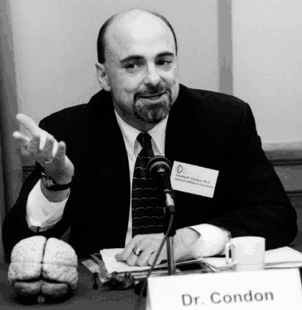|
In celebration of Brain Awareness Week last March, NIDA and 10 other institutes of the National Institutes of Health sponsored a variety of educational activities in Washington, D.C. Brain Awareness Week is an annual, worldwide effort organized by the Dana Alliance for Brain Initiatives, a foundation in New York City that promotes the public health benefits of brain research.
 Dr. Timothy P. Condon discusses programs that NIDA has developed to educate the public about research findings on drugs and the brain.
|
NIDA Director Dr. Alan I. Leshner introduced a symposium on scientists' use of sophisticated brain imaging technologies, such as single photon emission computed tomography and magnetic resonance imaging (MRI), to explore the living brain. One session, directed toward scientists, featured an overview and history of neuroimaging, as well as presentations by noted authorities on the neurobiology of addiction, uses for MRI, aging and cognition, and the mechanisms of attention. The audience viewed brain images on overhead monitors while speakers demonstrated how imaging techniques can literally illuminate the workings of the brain.
Dr. Leshner also welcomed the public to two presentations, "How Drugs and Stress Affect the Brain" and "Language and Spatial Abilities: Clues from the Inner Workings of the Brain." The first presentation focused on how drugs and stress may affect the brain, and the role that scientists and researchers play in providing information that will result in a better understanding of the significance of brain and drug addiction research. The second presentation provided a glimpse of some of the fascinating insights and fundamental questions concerning language and cognition raised by neuro-imaging.
Dr. Timothy P. Condon, associate director of NIDA, participated in "Talking Science to the Public." This was one of three panel discussions designed to acquaint an audience of scientists and professionals from around the country with ways to "get the word out" about science to various audiences, such as policymakers, the public, and the media. Dr. Condon discussed NIDA projects aimed at educating students and the general public about research into drugs and the brain. He cited "NIDA Goes to School," a compilation of resources for middle school students on how drugs work in the brain, as an example of the kinds of educational efforts conducted by NIDA.
|